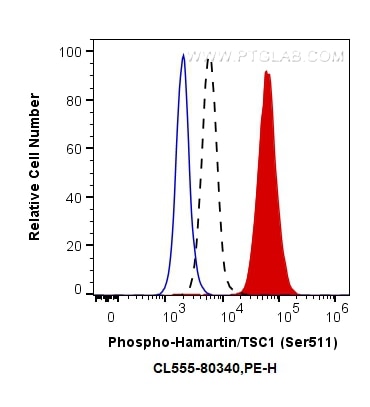Anticorps Recombinant de lapin anti-Phospho-Hamartin/TSC1 (Ser511)
Phospho-Hamartin/TSC1 (Ser511) Recombinant Antibody for FC (Intra)
Hôte / Isotype
Lapin / IgG
Réactivité testée
Humain, souris
Applications
FC (Intra)
Conjugaison
CoraLite®555 Fluorescent Dye
CloneNo.
3N6
N° de cat : CL555-80340
Synonymes
Galerie de données de validation
Applications testées
| Résultats positifs en FC (Intra) | cellules HeLa traitées à la calyculine A |
Dilution recommandée
| Application | Dilution |
|---|---|
| Flow Cytometry (FC) (INTRA) | FC (INTRA) : 0.50 ug per 10^6 cells in a 100 µl suspension |
| It is recommended that this reagent should be titrated in each testing system to obtain optimal results. | |
| Sample-dependent, check data in validation data gallery | |
Informations sur le produit
CL555-80340 cible Phospho-Hamartin/TSC1 (Ser511) dans les applications de FC (Intra) et montre une réactivité avec des échantillons Humain, souris
| Réactivité | Humain, souris |
| Hôte / Isotype | Lapin / IgG |
| Clonalité | Recombinant |
| Type | Anticorps |
| Immunogène | Peptide |
| Nom complet | tuberous sclerosis 1 |
| Masse moléculaire calculée | 130 kDa |
| Poids moléculaire observé | 150 kDa |
| Numéro d’acquisition GenBank | NM_000368 |
| Symbole du gène | Hamartin/TSC1 |
| Identification du gène (NCBI) | 7248 |
| Conjugaison | CoraLite®555 Fluorescent Dye |
| Excitation/Emission maxima wavelengths | 557 nm / 570 nm |
| Forme | Liquide |
| Méthode de purification | Purification par protéine A |
| Tampon de stockage | PBS with 50% glycerol, 0.05% Proclin300, 0.5% BSA |
| Conditions de stockage | Stocker à -20 °C. Éviter toute exposition à la lumière. Stable pendant un an après l'expédition. L'aliquotage n'est pas nécessaire pour le stockage à -20oC Les 20ul contiennent 0,1% de BSA. |
Informations générales
TSC1, also named as Hamartin, is a tumor suppressor gene syndrome whose manifestations can include seizures, mental retardation, autism, and tumors in the brain, retina, kidney, heart, and skin. The tuberous sclerosis 1 (TSC1)/TSC2 tumor suppressor complex serves as a repressor of the mTOR pathway, and disruption of TSC1/TSC2 complex function may contribute to tumorigenesis. TSC1 is phosphorylated by IKKb at Ser487 and Ser511 in vitro and in vivo, and phosphorylation at these sites enhances dissociation of the TSC1/TSC2 complex, which in turn induces mTOR activation. (PMID: 17693255). TSC1 is also threonine-phosphorylated at three sites (Thr417, Ser584, and Thr1047) in a reaction catalyzed by cyclin-dependent kinase 1 (CDK1) (PMID: 14551205).


